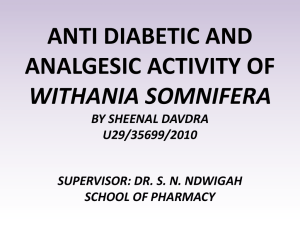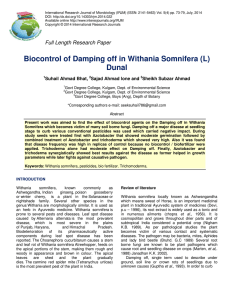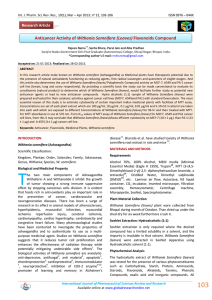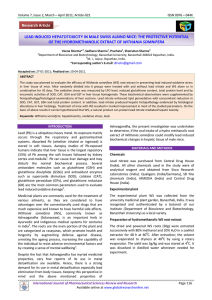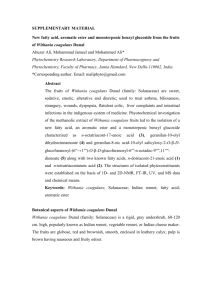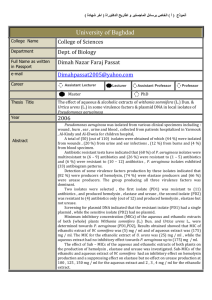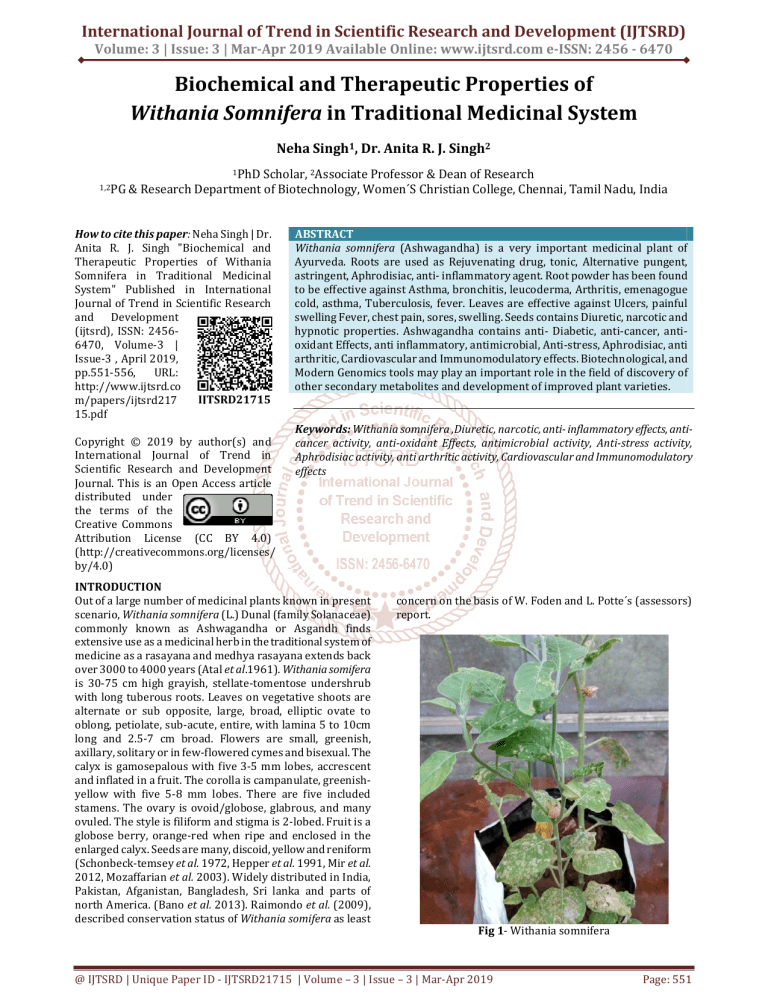
International Journal of Trend in Scientific Research and Development (IJTSRD)
Volume: 3 | Issue: 3 | Mar-Apr 2019 Available Online: www.ijtsrd.com e-ISSN: 2456 - 6470
Biochemical and Therapeutic Properties of
Withania Somnifera in Traditional Medicinal System
Neha Singh1, Dr. Anita R. J. Singh2
1PhD
Scholar, 2Associate Professor & Dean of Research
1,2PG & Research Department of Biotechnology, Women´S Christian College, Chennai, Tamil Nadu, India
How to cite this paper: Neha Singh | Dr.
Anita R. J. Singh "Biochemical and
Therapeutic Properties of Withania
Somnifera in Traditional Medicinal
System" Published in International
Journal of Trend in Scientific Research
and Development
(ijtsrd), ISSN: 24566470, Volume-3 |
Issue-3 , April 2019,
pp.551-556,
URL:
http://www.ijtsrd.co
IJTSRD21715
m/papers/ijtsrd217
15.pdf
Copyright © 2019 by author(s) and
International Journal of Trend in
Scientific Research and Development
Journal. This is an Open Access article
distributed under
the terms of the
Creative Commons
Attribution License (CC BY 4.0)
(http://creativecommons.org/licenses/
by/4.0)
ABSTRACT
Withania somnifera (Ashwagandha) is a very important medicinal plant of
Ayurveda. Roots are used as Rejuvenating drug, tonic, Alternative pungent,
astringent, Aphrodisiac, anti- inflammatory agent. Root powder has been found
to be effective against Asthma, bronchitis, leucoderma, Arthritis, emenagogue
cold, asthma, Tuberculosis, fever. Leaves are effective against Ulcers, painful
swelling Fever, chest pain, sores, swelling. Seeds contains Diuretic, narcotic and
hypnotic properties. Ashwagandha contains anti- Diabetic, anti-cancer, antioxidant Effects, anti inflammatory, antimicrobial, Anti-stress, Aphrodisiac, anti
arthritic, Cardiovascular and Immunomodulatory effects. Biotechnological, and
Modern Genomics tools may play an important role in the field of discovery of
other secondary metabolites and development of improved plant varieties.
Keywords: Withania somnifera ,Diuretic, narcotic, anti- inflammatory effects, anticancer activity, anti-oxidant Effects, antimicrobial activity, Anti-stress activity,
Aphrodisiac activity, anti arthritic activity, Cardiovascular and Immunomodulatory
effects
INTRODUCTION
Out of a large number of medicinal plants known in present
scenario, Withania somnifera (L.) Dunal (family Solanaceae)
commonly known as Ashwagandha or Asgandh finds
extensive use as a medicinal herb in the traditional system of
medicine as a rasayana and medhya rasayana extends back
over 3000 to 4000 years (Atal et al.1961). Withania somifera
is 30-75 cm high grayish, stellate-tomentose undershrub
with long tuberous roots. Leaves on vegetative shoots are
alternate or sub opposite, large, broad, elliptic ovate to
oblong, petiolate, sub-acute, entire, with lamina 5 to 10cm
long and 2.5-7 cm broad. Flowers are small, greenish,
axillary, solitary or in few-flowered cymes and bisexual. The
calyx is gamosepalous with five 3-5 mm lobes, accrescent
and inflated in a fruit. The corolla is campanulate, greenishyellow with five 5-8 mm lobes. There are five included
stamens. The ovary is ovoid/globose, glabrous, and many
ovuled. The style is filiform and stigma is 2-lobed. Fruit is a
globose berry, orange-red when ripe and enclosed in the
enlarged calyx. Seeds are many, discoid, yellow and reniform
(Schonbeck-temsey et al. 1972, Hepper et al. 1991, Mir et al.
2012, Mozaffarian et al. 2003). Widely distributed in India,
Pakistan, Afganistan, Bangladesh, Sri lanka and parts of
north America. (Bano et al. 2013). Raimondo et al. (2009),
described conservation status of Withania somifera as least
concern on the basis of W. Foden and L. Potte´s (assessors)
report.
Fig 1- Withania somnifera
@ IJTSRD | Unique Paper ID - IJTSRD21715 | Volume – 3 | Issue – 3 | Mar-Apr 2019
Page: 551
International Journal of Trend in Scientific Research and Development (IJTSRD) @ www.ijtsrd.com eISSN: 2456-6470
Biochemical profile of Withania somnifera
Several biochemical constituents such as alkaloids,
flavonoides, steroidal lactones, tannins, saponins etc has
have been extracted, and identified from Withania species
(Lavie et al. 1965, Kirson et al. 1977, Eastwood et al. 1977,
Atta ur Rehman et al. 1991 & 93, Chaudary et al. 1996,
Rastogi et al 1998, Kapoor 2001, Bandopadhyay et al 2007).
Roots and leaf extracts of W. Somnifera indicates that it
possesses anti-inflammatory, antitumor, anti stress,
antioxidant, immune-modulatory properties (Singh et al.
2011). Udayakumar et al. (2009) reported antidiabetic
activity in alloxan model mice.
The withanolide skeleton may be defined as a 22hydroxyergostan-26-oic acid-26,22-lactone. Some variation
in carbocyclic skeleton or the side chain and these have been
studied and described as modified withanolides or
ergostantype steroids related to withanolides. The
characteristic feature of withanolides and ergosane-type
steroids is one C8 or C9-side chain with a lactone or lactol
ring but the lactone ring may be either six-membered or
fivemembered and may be fused with the carbocyclic part of
the molecule through a carbon-carbon bond or through an
oxygen bridge. Appropriate oxygen substituents may lead to
bond scission, formation of new bonds, aromatization of
rings and many other kinds of rearrangements resulting in
compounds with novel structures [Tursunova et al. 1977,
Glotter et al. 1991, Kirson et al. 1971].
RootsDry root powder and various chemical root extracts are
found to be effective against various illnesses. In Ayurvedic
medicinal system roots are used as Rejuvenating drug, tonic,
Alternative pungent, astringent, Aphrodisiac, Phthisis (Dutta
1877, Kumar et al. 1980, Sen Gupta 1984) , in Siddha
medicinal system it is effective against fever (SPC 1992), and
inflammation and according to Unaani system it is found to
be effective against Asthma, bronchitis, leucoderma,
Arthritis, emenagogue (Stewart 1869, Maithani 1973 and
according to Folklare system roots can be used against cold,
asthma, Tuberculosis, fever (Dutta 1877), Kumar et al. 1980,
Singh and Kumar 1998). Dry root powder contains
Antiulcerogenic, Antistress, Anticancer & Radiosensitizer,
Psyco-physiological, Pulmonary tuberculosis, Epilepsy,
Nervinetonic, Easy abortion, General tonic in seminal
disease, Glandular swellings in bubonic plague, Hypoglycemic diuretic properties. 70% Methanolic extract contains
Antistress.,GABA mimetic activity GABA receptor mediates
anti-convulsant activity, Protective effect as amygdaloid
kidlling Antiiinflammatory effects. Chloroform-Methanol
extract is effective against Alzheimers disease (Sehgal et al.
2012).
LeavesAccording to Ayurveda leaves are effective against Ulcers,
painful swelling (Dutta 1877, Kumar et al. 1980, Singh and
Kumar 1998, Mhaskar et al. 2000. Siddha system leaves are
effective against Fever, chest pain, sores, swelling (SPC
1992), Unani- External pains, anti-inflammatory (UPC 1993)
Folklare Cure eyesores, boils, diuretic Narcotic, treatment of
syphilis and hemorrhoids (Shah and Gopal 1985, Sharma et
al. 1985)
SeedsAccording to Ayurveda seeds contains Diuretic, narcotic and
hypnotic properties (Dalzell and Gibson, 1861), Folkalre
system seeds are found to be effective against open wounds
and poison of a serpent rubbed on skin for ringworm in
human beings and animals ( Dalzell and Gibson 1861, Rao
1977, Sahu 1982, Shah and Gopal 1985, Dafni and Yaniv
1994).
Pharmacological Profile of Withania sonifera
AntiDiabetic activity –
Six withanolides isolated from W. somnifera were tested for
anti-diabetic activity based on glucose uptake in skeletal
myotubes. Withaferin A was found to increase glucose
uptake, with 10μM producing a 54% increase compared with
control, suggesting that withaferin A is at least partially
responsible for W. somnifera's anti-diabetic activity
(Gorelick et al. 2015).
Anticancer activity –
Withaferin A and withanolide D are anti-tumor and radiosensitizing withanolides (Devi et al. 1992, 1993, 1999; Lyon
and Kuttan, 2004). 1-oxo-5ß, 6β-epoxy-witha-2-enolide
reduces the UV induced skin carcinoma (Mathur et al. 2004).
Withaferin A acts as a mitotic poison arresting the division of
the cultured human larynx carcinoma cells at metaphase. It
also produced a significant dose dependent retardation of
the growth of Ehrlich ascites carcinoma, sarcoma 180, and
sarcoma Black and E 0771 mammary adenocarcinoma
(Davis and Kuttan, 1998). Methanolic extract of W. somnifera
has been used in stem cell proliferation (Kuttan, 1996). It
acts like a chemotherapeutic agent and inhibits the growth of
breast, lung, central nervous system and colon cancer cell
lines by decreasing their viability in doze dependent manner
(Jayaprakasan et al. 2003). The withaferin A-mediated
suppression of breast cancer cell viability correlated with
apoptosis induction characterized by DNA condensation,
cytoplasmic histone–associated DNA fragmentation, and
cleavage of poly-(ADP-ribose)-polymerase (Silvia et al.
2008). Chemo-preventive activity is attributed partly to the
antioxidant/free radical scavenging activity of the extract
(Prakash et al. 2002)
Antioxidant Effects –
Brain and nervous tissues are rich in lipid and iron content
which promotes the synthesis or generation of free oxygen
species, so in comparison of other physiological system they
are more susceptible to free radical damage. ( Halliwell &
Gutteridge, 1989). And this free radical or newly synthesized
oxygen molecule may cause neural loss in cerebral ischemia,
aging and neurodegenerative diseases, e.g., epilepsy,
schizophrenia, Parkinson’s, Alzheimer’s and other diseases
(Jesberger & Richardson, 1991, Sehgal et al., 2012). W.
somnifera, contains sitoindosides VII-X and withaferin A
(glycowithanolides), is responsible to increase the amount of
endogenous superoxide dismutase (SOD), catalase (CAT),
glutathione peroxidase (GPX), and ascorbic acidand
decreases the lipid peroxidation (Dhuley 1998, Bhattacharya
et al. 2001, Jayaprakasam et al. 2004, Bhatnagar 2005,
Mirjalali et al. 2009).
Anti inflammatory activity –
Ashwagandha acts as an anti-inflammatory agent in
rheumatological conditions and by inhibiting the
complement, lymphocyte proliferation, and delayed-type
hypersensitivity (Rasool & Varalakshmi, 2006, Anbalagan et
al. 1984, Al-Hindawi et al. 1992). Ashwagandha extract can
100 % decrease the glycosaminoglycans content in the
granuloma tissue and may uncoupled the oxidative phospho-
@ IJTSRD | Unique Paper ID - IJTSRD21715 | Volume – 3 | Issue – 3 | Mar-Apr 2019
Page: 552
International Journal of Trend in Scientific Research and Development (IJTSRD) @ www.ijtsrd.com eISSN: 2456-6470
rylation by reducing mitochondrial ADP/O ratio in
mitochondria of granuloma tissue andmay increase the
Mg2+ dependent-ATPase enzyme activityand reduces the
succinate gehydrogenase activity in mitochondria (Begum et
al. 1988).
Antimicrobial effects –
The antibacterial properties of this multipronged medicinal
plant were for the first time reported by Kurup (1956)
against Salmonella aurens. In past one decade, antimicrobial
activity against a range of bacteria and fungi ascribed to
withanolide were reported (Dhuley, 1998, Ziauddin et al,
1996, Dhuley, 1998, Mishra et al, 2000, Owais et al, 2005).
Anti-stress and Aphrodisiac activity –
Anti-stress activity associated with glycosides (sitoindosides
VII and VIII) present in this plant was reported by Bhattacharya (1987; 2000 & 2003). Ashwagandha is also used as
a tonic in the treatment of spermatopathia, impotence and
seminal depletion (Nadkarni, 1976) and the men who used
the herb enjoyed higher vigour performance (Boone, 1998).
The higher concentrations of inorganic elements like Fe, Mg,
K and Ni in the roots of this plant play a significant role in the
diuretic and aphrodisiac activity of the drug (Lohar et al.,
1992). The decoction of the root boiled with milk and ghee is
recommended for curing sterility in women (Singh & Kumar
1998).
Anti Arthritic properties –
Ashwagandha powder has been found useful in acute
rheumatoid arthritis and reduces the discomfort associated
with arthritis (Bector et al. 1968). This property has been
attributed to the active principle withaferin A.
Cardiovascular effects –
Various extracts of W. somnifera has been reported that it
shows hypotensive effect to autonomic ganglion blocking
action as well as a depressant action on the higher cerebral
centers. Recent study proves that W. somnifera act as a a
cardio-protective agent that provides a scientific reason for
rationale of the use of this medicinal plant in Ayurveda as
Maharasayana (Gupta et al. 2004, Mohanty et al. 2004,
Sehgal et al. 2012).
Effects on nervous system –
The effects on nervous system are associated with
Ashwagandholine (root extracts). It potentiates barbiturate-,
ethanol- and urethane- induced hypnosis in mice and caused
relaxant and antispasmodic effects against various agents
that produce smooth muscle contractions in intestinal,
uterine, tracheal and vascular muscles (Malhotra et al.
1965). The bioactive compounds are reported to
preferentially influence the events in the cortical and basal
forebrain cholinergic-signal transduction cascade. The
cognition and memory enhancing ef fects of W. somnifera
extracts can be partly explained by the drug-induced
enhancement of cortical muscarinic acetylcholine receptor
capacity (Schliebs et al. 1997). In general, Ashawagandha has
been used traditionally as a tonic and no tropic agent (Sehgal
et al., 2012). It has also been associated with improvements
in scopolamine-induced memory deficits in mice (Dhuley,
2001). W. somnifera extracts also show an antiparkinsonian
effect on neuroleptic-induced catalepsy by inhibiting
haloperidol or reserpine-induced catalepsy attributed to
potent antioxidant, antiperoxidative and free radical
quenching properties (Ahmad et al., 2005; Kumar &
Kulkarni, 2006; Sehgal et al.,2012).
Immunity –
Roots of W. somnifera shows an immuno-potentiating and
myeloprotective effects by enhancing the levels of interferon
(IFN)-γ, interleukin (IL)-2 and granulocyte macrophage
colony stimulating factor in normal and cyclophosphamidetreated mice (Davis & Kuttan, 1999). As the plant is rich in
iron, it contributes to red blood cell count. The effect of W.
somnifera on the immune system is subtler than simply
suppressing the immune/ inflammatory response. The active
compound (withanolide A) in the roots of W. somnifera
significantly increases the expression levels of T-helper 1
(Th1) cytokines, as well as CD4 and CD8 counts. It also
enhances natural killer (NK) cell activity in a dose dependent
manner with a faster recovery of CD4+ T cells in immune
suppressed animals (Davis & Kuttan, 2002, Khan et al., 2006,
Bani et al., 2006, Singh et al., 2008). Apart from the above
activated macrophage functioning indicated by enhanced
secretion of nitrile, IL-2 and TNF-2, decreases moderately IL4 with no effect on IL-10 suggesting that it only influenced
Th1 profile of the cytokines. Root powder of this plant is also
reported to stimulate the cell-mediated immunity, IgM and
IgG and a prominent enhancement in proliferation and
differentiation of lymphocytes as indicated by lymphocyte
surface markers of T cells (CD3+, CD4+ and CD8+) and B
cells (CD19+) (Singh et al., 2008).
Immunomodulatory effects Glycowithanolides and a mixture of sitoindosides IX and X
isolated from W. somnifera were evaluated for their
immunomodulatory and central nervous system effects
(Ghosal et al., 1989). Administrated orally (50-200 mg/kg
orally) both compounds also produced significant antistress
activity in albino mice and rats. They also augmented
learning, acquisition and memory retention in both young
and old rats. Root extract of W. somnifera was tested for
immunomodulatory effects in three myelosuppression
models in mice: cyclophosphamide, azathioprin or
prednisolone (Ziauddin et al. 1996). Significant increase in
hemoglobin concentration, red blood cell count, white blood
cell count, platelet count and body weight were observed in
W. somnifera -treated mice compared to controls. A
significant increase in hemolytic antibody responses toward
human erythrocytes (which indicated immunostimulatory
activity) was also reported.
ConclusionWithania somnifera is very important plant species from
medicinal point of view. Dry root powder of Ashwagandha is
commercially available as raw material of various ayurvedic
formulations in market. These reviews are evidence that
various other biochemical constituents of leaves and seeds of
Ashwagandha should be study more extensively to reveal the
other medicinal benefits. So that in future whole plant of
ashwagandha will be utilize for the treatment of various
illness.
Refferences[1] Al Hindawi M.K, Al Khafaji S.H and Abdul-Nabi M.H.
Anti-granuloma activity of Iraqi Withania somnifera. J.
Ethnopharmacol . (1992) 37, 113-116.
[2] Ahmad, M., Saleem,A., Ahmad, S., Ansari, M., A., Yousuf,
A., Hoda,M., N., and Islam, F. Neuroprotective effects of
@ IJTSRD | Unique Paper ID - IJTSRD21715 | Volume – 3 | Issue – 3 | Mar-Apr 2019
Page: 553
International Journal of Trend in Scientific Research and Development (IJTSRD) @ www.ijtsrd.com eISSN: 2456-6470
Withania somnifera on 6-hydroxydopamine induced
Parkinsonism in rats. Hum. Exp. Toxicol. (2005). 24(3):
137-147.
[18] Dafni A. and Yaniv Z. Solanaceae as medicinal plants in
Israel. Journal of Ethnopharmacology. (1994). 44, 1118.
[3] Anbalagan K, Sadique J. Role of prostaglandins in acute
phase proteins in inflammation. Biochem Med. (1984)
19:245:24.
[19] Dalzell N. A.and Gibson A. In the Bombay flora together
with a supplement of induced species (Bombay).
(1861).
[4] Atal, C. K. and Schwarting, A. E. Ashwagandha, an
ancient drug. Economic Botany, (1961). 15,256-263
[20] Davis L and Kuttan G. Suppressive: Effect of
cyclophosphamide-induced toxicity by Withania
somnifera extract in mice. J. Ethnopharmacol. (1998)
62, 209-214.
[5] Atta-ur-Rahman, Jamal, A.S., Choudary, M .I., Asif, I. Two
withanolides from Withania somnifera. Phytochemistry,
(1991). 30, 3824-3825.
[6] Atta-ur-Rahman, Abbas, S., Dur-e-Shawar, Jamal, A.S.,
Choudhary, M.I. New withanolides from Withania spp. J.
Nat. Prod., (1993). 56, 1000-1006.
[7] Bandopadhyay M., Jha S., Tepfer D. Changes in
morphological
phenotypes
and
withanolide
composition of Ri –Transformed roots of Withania
somnifera . Plant cell Rep. (2007). 26, 599-609.
[8] Bano A, Ayub M, Rashid S, Sultana S and Sadia H.
Ethnobotany and conservation status of floral diversity
of Himalayan range of Azad Jammu and Kashmir
Pakistan. Pakistan Journal of Botany. (2013). 45: 243251.
[9] Bector N.P, Puri A.S, Sharma D. Role of Withania
somnifera (Ashwagandha) in various types of
Arthropathies. Ind. J. Med. Res. (1968). 56, 1581-1583.
[10] Begum V. H. and Sadique J. Long term effect of herbal
drug Withania somnifera on adjuvant induced arthritis
in rats. Ind. J. Exp. Biol. (1988). 26, 877-882.
[11] Bhatnagar M, Sisodia SS and Bhatnagar R Antiulcer and
antioxidant activity of Asparagus racemosusWILLD and
Withania somnifera DUNAL in Rats. Ann. NY Acad. Sci.
(2005) 1056, 261-278.
[12] Bhattacharya SK, Goel RK, Kaur R, Ghosal S. Anti-tress
activity of sitoinosides VII and VIII, new acylsteryl
glucosides from Withania somnifera. Phytother. Res.
(1987). 9: 10-13.
[13] Bhattacharya A, Ghosal S and Bhattacharya S.K
.Antioxidant
effect
of
Withania
somnifera
glycowithanolides in chronic footshock stress-induced
perturbations of oxidative free radical scavenging
enzymes and lipid peroxidation in rat frontal cortex
and striatum. J. Ethnopharmacol . (2001) 74: 1-6.
[14] Bhattacharya A, Ramanathan M, Ghosal S, Bhattacharya
SK. Effect of Withania somnifera glycowithanolides on
iron-induced hepatotoxicity in rats. Phytother Res.
(2000) 14(7):568-570.
[15] Bhattacharya, S., K., Muruganandam, A., V. Adaptogenic
activity of Withania somnifera: an experimental study
using a rat model of chronic stress. Pharmacol.
Biochem. Behav. (2003) 75(3): 547-555.
[16] Boone K. Withania-The Indian ginseng and anti-aging
adaptogen. Nutr. Healing. (1998). 5, 5-7.
[17] Choudary, M.I., Abbas, S., Jamal, A.S. and Atta-urRahman. Withania somnifera- A source ofexotic
withanolides. Heterocycles (1996). 42, 555-563.
[21] Davis L, Kuttan G. Effect of Withania somnifera on
cytokine production in normal and cyclophosphamide
treatment mice. Immunopharmacol & Immunotoxicol.
(1999). 21(4):695-703.
[22] Devi P. U, Sharada A. C, Solomon F. E and Kamath M. S.
Invivo growth inhibitory effect of Withania somnifera
(Ashwagandha) on a transplantable mouse tumor,
Sarcoma 180. Ind. J. Exp. Biol. (1992) 30, 169-172.
[23] Devi P. U, Sharada A. C and Solomon F. E. Antitumor
and radiosensitizing effects of Withania somnifera
(ashwagandha) on a transplantable mouse tumor,
Sarcoma-180. Ind. J. Exp. Biol. (1993) 31, 607-611.
[24] Devi P.U. Withania somnifera dunal (ashwagandha):
Potential plant source of a promising drug for cancer
chemotherapy and radiosensitisation. Ind. J. Exp. Biol.
(1999). 34 (10), 927–932.
[25]
Dhuley J. N. Effect of Asgand on lipid peroxidation in
stress induced animals. J Ethnopharmacol. (1998).
7:173-178.
[26] Dhuley, J., N. Nootropic-like effect of Ashwagandha
(Withania somnifera L.) in mice. Phytother. Res. (2001).
15(6): 524-528.
[27] DuttaU. C. and King G. Materia medica of Hindus.
Calcutta Machine Press. (1877).
[28] Eastwood FW, Kirson I, Lavie D and Abraham A. New
withanolides from a cross of a South African
chemotype by chemotype II (Israel) in Withania
somnifera. Phytochem. (1980). 19, 1503-1507.
[29] Ghosal S, Lal J and Srivastava R. Immunomodulatory
and CNS effects of sitoindosides IX and X, two new
glycowithanolides from Withania somnifera. Phytother.
Res. (1989) 3, 201-206.
[30] Glotter, E. Withanolides and related ergostane-type
steroids. Nat. Prod. Rep. ( 1991). 8, 415-440.
[31] Gorelick J, Rosenberg R, Smotrich A, Hanus L and
Bernstein N. Hypoglycemic activity of withanolides and
elicitated Withania somnifera. Phytochemistry. (2015).
[32] Gupta M.L, Mishra A.K and Khanduja S.P.S Root rot and
wilt: A new disease of Ashwagandha (Withania
somnifera)caused by Fusarium solani. Journal of
Medicinal and Aromaticplant sciences. (2004). 26, 285287.
[33] Halliwell B and Gutteridge , J.M.C. Free radicals in
biology & medicine.( 2nd ed. Oxford: clarendon press.
(1989).
[34] Hepper, F.N. In Solanaceae III: taxonomy, chemistry,
evolution; Hawkes, J.G., Lester, R.N., Nee, M., Estrada, E.,
@ IJTSRD | Unique Paper ID - IJTSRD21715 | Volume – 3 | Issue – 3 | Mar-Apr 2019
Page: 554
International Journal of Trend in Scientific Research and Development (IJTSRD) @ www.ijtsrd.com eISSN: 2456-6470
somnifera (Indian ginseng) : an ayurvedic medicinal
plant. Indian Journal of Drugs and Diseases. (2012). 1
[6] 147-160.
Eds.; Royal Botanic Gardens, Kew: UK. (1991) pp. 211227.
[35] Jayaprakasam B, Zhang Y. Seeram N.P and Nair M.G.
Growth inhibition of human tumor cell lines by
withanolides from Withania somnifera leaves. Life Sci.
(2003) 74, 125-132.
[36] Jayaprakasam, B.; Strasburg, G.A.; Nair, M.G. Potent
lipid peroxidation inhibitors from Withania somnifera
fruits. Tetrahedron (2004). 60, 3109-3121.
[37] Jesberger J. A and Richardson J. S. Oxygen free radicals
and brain dysfunction. Int. J. Neurosci. (1991). 57, 1-17.
[38] Kapoor, L.D. Handbook of Ayurvedic Medicinal Plants;
CRC Press: London, UK. (2001). pp. 337-338.
[39] Kirson, I, Glotter, E, Lavie, D and Abraham, A.
Constituents of Withania somnifera Dun. XII. The
withanolides of an Indian chemotype. J. Chem. Soc. C,
(1971). 2032-2044.
[40] Kirson I., Abraham A. and Lavie D. Chemical analysis of
hybrids of W. somnifera L. (Dunal) chemotype I and III
Israel by Indian I (Delhi). Israel. J. Chem. (1977) 16, 2024.
[41] Kumar S, Tiwari, A. And Dwivedi R. The use of
aphrodisiacs in Medieval India. Nagarjun, (1980).
23:170-174.
[42] Kumar, S.K. Kulkarni. Effect of BR-16A (Mentat), a
polyherbal formulation drug-induced catalepsy in mice.
Indian J. Exp. Biol. (2006). 44(1): 45-48.
[43] Kurup P.A. Antibiotic principals of the leaves of
Withania somnifera. Curr. Sci. 25, 57-60.
[44] Kuttan G (1996) Use of Withania somnifera Dunal as an
adjuvant during radiation therapy. Ind. J. Exp. Biol.
(1956) 34, 854-856.
[45]
Lavie D, Glotter E, Shro Y. Constituents of Withania
somnifera. Dun IV. J Chem Soc. (1965). 12:7517.
[53] Mirjalili MH, Moyano E, Bonfill E, Cusido RM and
Palazón J. Steroidal Lactones from Withania somnifera,
an an-cient plant for novel medicine. Molecule, (2009)
14, 2373-2393.
[54] Mishra L.C, Singh B.B and Dagenais S. Scientific basis
for the therapeutic use of Withania somnifera
(Ashwagandha): A Review. Altern Med. Rev. (2000)
5(4), 334-346.
[55] Mohanty I, Arya D.S, Dinda A, Talwar K.K, Joshi S, Gupta
S.K. Mechanism of cardioprotective effect induced
myocardial infarction. Bas & Clin Pharm & Toxicol.
(2004). 94(4):184-190.
[56] Mozaffarian, V. Trees and shrubs of Iran; Farhange
Moaser: Tehran, Iran, (2003). pp. 874-877.
[57] Nadkarni K. M. Indian materia medica, (Popular
Prakshan Limited: Bombay, India. (1976). 1291.
[58] Owais, M., Sharad K.S., Shehbaz, A. and Saleemuddin M.
Antibacterial efficacy of Withania somnifera
(Ashwagandha) an indigenous medicinal plant against
experimental murine salmonellosis. Phytomedicine.
(2005) 12(3): 229-235.
[59] Prakash J, Gupta S K. and Dinda A K. Withania
somnifera root extract prevents DMBA-induced
quamous cell carcinoma of skin in Swiss albino mice.
Nutr. Cancer. (2002) 42, 91-97.
[60] Raimondo D, Von Staden L, Foden W, Victor J.E, Helme
N. A, Turner R. C, Kamundi D. A, and Mayama P. A Red
list of south African national biodiversity institute
Pretoria. (2009).
[61] Rao R. R. Medicobotany of some Mysore plants. J. Res.
Ind. Med. Yoga Homoeo. (1977). 12: 53-58.
[46] Leyon PV and Kuttan G. Effect of Withania somnifera on
B16F-10 melanoma induced metastasis in mice. Phytother. Res. (2004) 18, 118-122.
[62] Rasool M and Varalakshmi P. Immunomodulatory role
of Withania somnifera root powder on experimental induced inflammation: an in vivo and in vitro study.
Vascul. Pharmacol. (2006) 44, 406-410.
[47] Lohar DR, Chaturvedi D and Varma P. N. Mineral
elements of a few medicinally important plants, Ind.
Drugs. (1992). 29, 271-273.
[63] Rastogi, R.P. and Mehrotra, B.N. Compendium of Indian
Medicinal Plants; Central Drug Research Institute: New
Delhi, India. (1998).
[48] Maithani B. P. Medicinal plants of western garhwal.
Khadi gramodyog. (1973). 19, 269-278.
[64] Sahu T.R. An ethnobotanical study of Madhya
pradesh1: plants used against various disorders among
tribal women. Ancient science of life(1982). 1, 178-181.
[49]
Malhotra C. L, Mehta V. L, Das P. K, Dhalla N. S. Studies
on Withania-ashwagandha, Kaul (Part-V) The effect of
total alkaloids (ashwagandhadholine) on the central
nervous system. Ind J Physiol Pharmacol. (1965).
9:127-136.
[50] Mathur S, Kaur P and Sharma M. The treatment of skin
carcinoma induced by UV B radiation, using 1-oxo-5beta, 6beta -epoxy-with a-2-enolide, isolated from the
roots of Withania somnifera, in a rat model. Phytomed.
(2004). 11, 452-460
[51] Mhaskar K S, Blatter E, Caius J F Indian Medicinal Plants
(Sri Satguru Publications, Delhi, India). (2000). Vol 8,
2447-2449.
[52] Mir B A., Khazir J., Mir N A., Hasan T., Koul S. Botanical,
chemical and pharmacological review of Withania
[65]
Schliebs R, Liebmann A, Bhattacharya S.K, Kumar A,
Ghosal S, Bigl V. Systematic administration of defined
extracts from Withania somnifera (Indian Ginseng) and
Shilajit differentially affects cholinergic but not
glutamatergic and GABAergic markers in rat brain.
Neurochem Int. (1997) 30:181-190.
[66] Sehgal N, Gupta A, Khader R, Shanker V, Joshi D, Mills
JT, Hamel E, Khanna P, Jain S.C, Thakur S.S, and
Ravindranath V. Withania somnifera reverses
Alzheimer’s disease pathology by enhancing lowdensity lipoprotein receptor-related protein in liver.
Proc. Nat. Acad. Sci. (2012) 109(9), 3510-3515.
[67] Sen Gupta N. N. K. The ayurvedic system of medicine.
(Delhi, Neeraj Publishing House ) Vol II.
@ IJTSRD | Unique Paper ID - IJTSRD21715 | Volume – 3 | Issue – 3 | Mar-Apr 2019
Page: 555
International Journal of Trend in Scientific Research and Development (IJTSRD) @ www.ijtsrd.com eISSN: 2456-6470
[68]
Shah, G. L., and Gopal, G. V. (1985).Ethnomedical notes
from the tribal inhabitants of the North Gujarat (India).
Journal of Economic and Taxonomic Botany (1984).
6(1): 193-201.
[69] Sharma S., Dahanukar S., Karandikar S.M. Indian drugs,
(1985) 23, 133.
[70] Singh N, Bhalla M, De Jager P and Glica M. An overview
on ashwagandha : A rasayana (Rejuvinator) of
ayurveda. African journal of Traditional, complementary
and alternative medicines: AJTCAM. (2011). 8(5), 208213.
[71] Singh S, Kumar S. Withania somnifera The Indian
Ginseng- Ashwagandha. CIMAP, Lucknow, India.
(1998).
[72]
Silvia D.S., Eun R.H., Renaud W and Shivendra V. S.
Withaferin A Causes FOXO3a- and Bim-Dependent
Apoptosis and Inhibits Growth of Human Breast Cancer
Cells In vivo. Can. Res. (2008). 68, 7661-7669.
[73] Schonbeck-Temesy, E. In Flora Iranica; Rechinger, K.H.,
Ed. Akademische Druck-u.Verlagsanstalt: Graz, Austria.
No. (1972). 100, pp. 29-26.
[74] SPC( The Sidha Pharmacopoeia Committee). Compound
formulations in the Sidha formulatory of India. Part- I .
(New Delhi Ministry of Health and Family Welfare)
First edition. (1992).
[75] Stewart L. Punjab plants comprising Botanical and
vernacular names and uses of most of the trees, shrubs,
and herbs of economical value, growing within the
province (Lahore, British India: The Government
Press). (1969).
[76] Tursunova, R.N.; Maslennikova, V.A.; Abubakirov, N.K.
Withanolides in the vegetable kingdom. Chem. Nat.
Comp. (1977). 13, 131-138.
[77] Udayakumar R, Kasthurirengan S, Mariashibu T. S,
Rajesh M, Anbazhagan V. R, Kim S. C, Ganapathi A, Choi
C. W. Hypoglycaemic and hypolipidaemic effects of
Withania somnifera root and leaf extracts on alloxaninduced diabetic rats. Int J Mol Sci. (2009). 10(5):23672382.
[78]
UPC (The Unani Pharmacopoeia Committee).
Compound formulations in the National formulatory of
Unani medicine . Part- I . (New Delhi Ministry of Health
and Family Welfare) (1983). First edition.
[79] Ziauddin M, Phansalkar N, Patki P, Diwanay S,
Patwardhan B. Studies on the immunomodulatory
effect of Asgandh. J Ethnopharmacol. (1996). 50(2):6976.
@ IJTSRD | Unique Paper ID - IJTSRD21715 | Volume – 3 | Issue – 3 | Mar-Apr 2019
Page: 556

